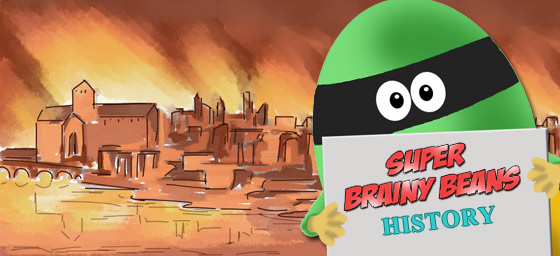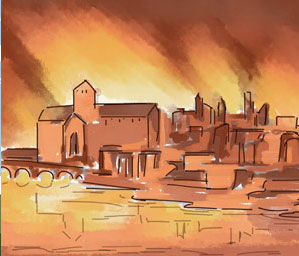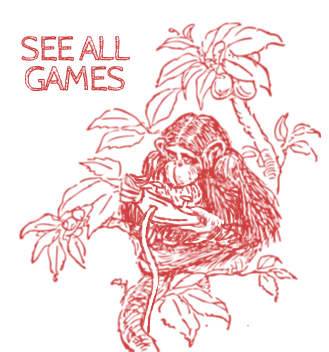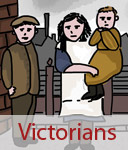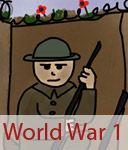Great fire of London
Great Fire of London the story from 1666. Homework help with the history of the Great Fire how the Great Fire of London started and how it ended.
Time: 1666
How did the Great Fire of London start?
 A year after the terrible plague that killed around one hundred thousand people, London in 1666 was a crowded, smelly, and very dirty city. The houses were built close together from wood, with thatched roofs and narrow streets between them — perfect for a fire to spread. The summer had been long and hot, and the River Thames was lower than usual. Everything was dry, and people were already worried there might be a drought.
A year after the terrible plague that killed around one hundred thousand people, London in 1666 was a crowded, smelly, and very dirty city. The houses were built close together from wood, with thatched roofs and narrow streets between them — perfect for a fire to spread. The summer had been long and hot, and the River Thames was lower than usual. Everything was dry, and people were already worried there might be a drought.
Just after midnight on Sunday, 2nd September 1666, a baker named Thomas Farynor (sometimes spelt Farriner) finished his work at his bakery on Pudding Lane and went to bed. He thought he had put out all his ovens, but a tiny spark was still burning. It fell onto a pile of straw and sticks — and soon the bakery was on fire!
Thomas and his family managed to escape through a window, but the fire spread quickly through the wooden houses nearby.
 The Great Fire Game
The Great Fire Game See what it was like during the fire. Help two people cope with the fire.
How did the fire spread?
Only two hours after going to bed, Thomas Farynor woke up coughing — his house was full of thick, choking smoke! The bakery was in flames, and his family had to climb out of an upstairs window to escape. Their maid was too frightened to jump and sadly became the first person to die in the Great Fire of London.
Once the baker’s house had burnt down, the fire quickly spread. A strong east wind blew burning embers and sparks through the air. These landed on nearby wooden houses and warehouses by the River Thames, which were filled with oil, tar, ropes, and barrels of brandy — all things that burn very easily. When the flames reached them, they exploded into huge fireballs that made the fire even worse!
By the time the sun came up on Sunday morning, around 300 houses had already been destroyed, and the fire was racing through the city faster than anyone could stop it. People ran through the narrow streets carrying buckets of water, trying to save their homes, but the fire was too strong.
When King Charles II heard how bad the fire had become, he sent soldiers to help and ordered people to pull down houses to make firebreaks — but by then, the blaze was out of control. Even churches, shops, and markets were burning, and the sky above London glowed red with flames.

How did they try to stop the fire?
 With so little water in the River Thames after the dry summer, it was almost impossible to put out the flames. The fire roared through the city, shooting thirty metres into the air and turning the night sky bright red. Buckets of water were passed from person to person, but the fire was far too big and strong.
With so little water in the River Thames after the dry summer, it was almost impossible to put out the flames. The fire roared through the city, shooting thirty metres into the air and turning the night sky bright red. Buckets of water were passed from person to person, but the fire was far too big and strong.
King Charles II ordered that houses in the path of the fire should be pulled down to make gaps — called firebreaks — so the flames couldn’t spread. But by the time people started pulling buildings down, the fire had already raced ahead, jumping across the gaps. The wind blew burning embers through the air, landing on rooftops and starting new fires everywhere.
By Tuesday — the third day of the fire — things were even worse. The flames reached Old St Paul’s Cathedral, one of the biggest and most famous buildings in London. The wooden scaffolding around it caught fire, and the great stone walls grew so hot that they cracked and exploded! Within hours, the mighty cathedral was nothing but a pile of glowing ruins.
Even King Charles II himself joined the fight. He helped pull down burning thatch roofs and threw buckets of water on the flames alongside the people of London. Soldiers and citizens worked side by side, but still the fire spread through street after street.
 Museum of London
Museum of LondonDiscover London before, during and after the Great Fire of 1666.
How did the Great Fire of London end?
After four long days of roaring flames and panic, the wind that had fed the fire finally changed. On Wednesday, 5th September 1666, the strong east wind dropped, and a gentle breeze from the north began to blow. At last, the flames stopped spreading, and people were finally able to control the fire. Using fire hooks, buckets of water, and even gunpowder to blow up houses and make firebreaks, Londoners fought to put out the last burning buildings.
When the smoke began to clear, people could see the terrible damage that had been done. Streets that had once been full of busy shops and houses were now covered in ashes and blackened ruins. The air was thick with smoke, and the smell of burnt wood hung over the city for weeks.

What was the damage from the fire?
Amazingly, only six people were recorded to have died — though many more may have perished but were never counted. Nearly four-fifths of London had been destroyed.
The fire destroyed:
- 87 churches, including the great St Paul's Cathedral
- 13,000 houses
- 44 company halls (where merchants met and worked)
- The Royal Exchange (London's main trading building)
- The Guildhall, where city meetings were held
Tens of thousands of people were left homeless and had to live in tents and shelters outside the city walls for months.
How did they go about rebuilding London after the fire?
After the Great Fire of London, the city was in ruins. Streets were filled with ashes and broken bricks, and around 200,000 people had lost their homes. There were many questions that needed answering:
- How do we rebuild London?
- How do we help the people who have lost everything?
- How do we make sure a fire like this never happens again?
The first job was to clear away the rubble and make the city safe. People built temporary wooden shelters for those who had lost their homes, and the King ordered that food and clean water be brought in to help them survive. Markets and small shops were set up quickly so that life could begin to return to normal.
Once the city was cleaner and safer, people began to think about how to rebuild it properly. King Charles II wanted London to be more beautiful and less dangerous than before. He ordered that new buildings should be made from brick and stone instead of wood, as they wouldn’t catch fire so easily.
 The Monument
The MonumentClimb The Monument and see great views of London. Built to commemorate the start of the Great Fire of London.
Who was Christopher Wren?

After the Great Fire of London, King Charles II wanted to rebuild the city to be bigger, grander, and much safer than before. To make this happen, he chose a very clever man named Sir Christopher Wren, who became the Surveyor of the King’s Works — which meant he was in charge of designing and rebuilding important buildings across the city.
Christopher Wren wasn’t just an architect; he was also a brilliant scientist and mathematician. Before the fire, he had studied stars and planets and even helped build telescopes! But after the fire, he turned his talents to helping London rise from the ashes.
Wren designed 51 new churches and planned wider streets and stronger buildings so fires wouldn’t spread so easily again. His most famous creation was the new St Paul’s Cathedral, which took over 35 years to build and was finally finished in 1711. It was built from strong Portland stone instead of wood, and its huge dome became one of the most famous landmarks in the world — you can still see it standing proudly in London today.
 St Pauls Cathedral
St Pauls CathedralVisit this amazing Cathedral. See the underground Crypt and the Golden Gallery, 111 metres above London.

